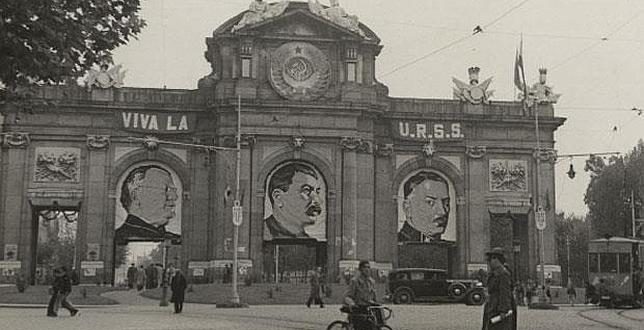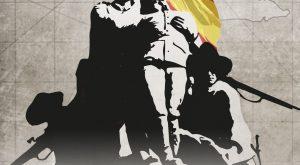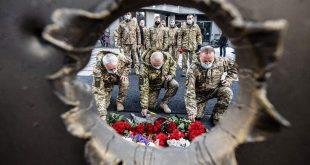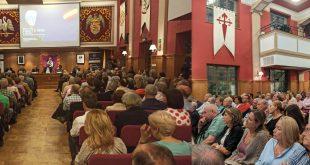The civil unrest and scattered violence of this past pandemic year in the United States was received with apparent passivity by most of the population, a mood doubtless encouraged by the lockdown. Critical commentary among conservatives, however, sometimes invoked terms such as “insurrection” or “revolution,” stimulated not merely by the events themselves but by the way that a combination of circumstances seemed to confirm the success of the remarkable politico-cultural transformation of the past half-century.
For more than two centuries, the term “revolution” has been in vogue, utilized in a bewildering variety of fashions, applied to rapid change in just about anything. It has become much more common than the now meaningless epithet “fascism,” for the latter is at least restricted to the world of politics.
The term came into political usage in the seventeenth century, but at first referred to a full cycle of rapid, drastic change and reordering of public affairs. In the original concept a revolution moved from the established order to sudden change—usually violent revolt, perhaps accompanied by a defiant new government—and then, normally, back to the established order or some slightly altered variant thereof. The greatest example was England from 1640 to 1660, going from monarchy to long and bloody civil war to a new protectorate and then back to monarchy once more, and thus a true “revolution,” categorically different from a protracted dynastic conflict, however bloody, such as the Wars of the Roses.
The modern concept of revolution as a complete and seemingly permanent change of polity emerged in the second half of the eighteenth century, when the American and French revolutions initiated the transition to modern politics. Contemporary observers nonetheless pointed out the differences between these experiences, and later—in the age of the socialist revolution—some would question whether the American experience had been a full modern revolution at all. The established state governments, religious institutions and social and economic structures were not greatly altered, a circumstance that served to explain the success of the process– basically a war of independence (later, “national liberation”) rather than a complete revolution in the French and Russian sense.
Robert Palmer termed the late eighteenth century “the age of the democratic revolution,” even though in France the consequences were much more far-reaching, resulting in dictatorship, the first modern state terrorism and genocide(in the Vendée massacres), aggressive modern nationalism, popular mass militarism and serial wars of conquest—all ending in complete failure after wreaking incalculable destruction. None of this prevented Napoleon from being a great symbolic hero to many in the decades that followed, though few nineteenth-century political rebels sought to emulate the entire French experience. For most of the century after 1815, revolutionaries promoted liberalism and/or nationalism, so that successful nineteenth-century “revolutions “were either liberal political breakthroughs or nationalist revolutions in the form of wars of liberation or unification.
From 1917, the predominant sense of “revolution” would stem from Russia as the “total revolution” of social and economic structure, religion, culture and government. Within two years, the new Soviet regime set up its Third or Communist International (Comintern) of Communist parties to promote revolution throughout the world. Though the Comintern enjoyed only limited success, the Red Army exported the Soviet model at the point of the bayonet to other lands as imposed “People’s Republics” (Mongolia in 1921-24 and later five occupied countries in Eastern Europe after 1945). Moreover, the three Baltic republics were seized and incorporated in 1940, as were large swathes of territory in eastern Poland (1939) and northeastern Romania (1940). These were partly old-fashioned imperialist land grabs, with Marxist-Leninist revolution applied from the top down by the conquerors. In East Asia, the Balkans and parts of Latin America and Africa, however, Communist movements developed independent force, though the struggle was long and the impact of World War II often crucial to initiating victory. By 1949, with the Communist victory in China, nearly a third of the world had fallen under Marxist-Leninist regimes, and the stage was set for the Cold War that would dominate the remainder of the century.
The spectrum of twentieth-century revolution was much broader than Communism, however, and included a great variety of movements and regimes whose classification would require a complex taxonomy. Several independent Communist regimes seized power in Africa by the mid-1970s, but in the “emerging nations” the revolution was primarily political, or in some cases state socialist without being Communist. The earlier Mexican Revolution of 1910-20 can hardly be classified. It was not socialist or communist, but neither was it, strictly speaking, capitalist. Harshly anticlerical, it was also populist but, like many revolutions, ended up becoming quite elitist. Above all, it was nationalist. Other Latin American countries attempted “populist revolution” with varying rates of success. The original Chinese Revolution of 1911 had not been socialist or communist, and only much later was it transformed into a Marxist-Leninist regime through a twenty-two-year civil war.
Revolution, whether success or failure, short-term or long-term, thus became a major feature of the past century, coming in three major waves a generation apart—after World War I, after World War II, and then amid the African decolonization and the Western cultural revolution of the 1960s. The collapse of East European Communism later seemed to mark a historic reversal of revolution, but apparently was instead part of a much more complex process of change of direction and content.
The study of revolution and its multiple manifestations became a large-scale industry, starting with the origins or causes, to determine exactly how revolutions occur. Amid multiple theories and interpretations, two stand out—the Marxist or materialist theory and the behavioral theory. The materialist theory holds that revolution stems from tensions or contradictions in the social and economic structure, from direct material causes. The behavioral concept emphasizes a complex of cultural, social, psychological and political factors subject to variable human agency.
Alexis de Tocqueville, whom Jon Elster has called “the first social scientist, ”formulated the behavioral theory of revolution in 1856, a quarter-century after his classic study of American democracy. In The Ancien Regime and the Revolution, the first part of what was to have been a multi-volume study of the French convulsion, he observed that “it was precisely in those parts of France where there had been the most improvement that popular discontent ran highest. This may seem illogical—but history is full of paradoxes.” Tocqueville explained that deteriorating conditions do not generally provoke revolution, but that in some societies complaints tend to increase after conditions have begun to improve. “The regime destroyed by a revolution is almost always better than the one that immediately preceded it and experience teaches us that the most hazardous moment for a bad government is normally when it is beginning to reform.” In general, the absolutist government of Louis XIV provoked less resentment than the milder rule of Louis XVI. The revolution of rising expectations, with its elevation of consciousness, is a key factor, even more important than objective material conditions. Once such attitudes have taken hold, some new crisis or setback, which may or may not be of profound importance in itself, triggers revolution.
James C. Davies has elaborated the point: “Revolutions are more likely to occur when a prolonged period of objective economic and social development is followed by a period of sharp reversal…. The actual state of socioeconomic development is less significant than the expectation that past progress, now blocked, can and must continue into the future.” Theodore S. Hamerow concurs: “Economic privation is not the key factor in the downfall of established authority any more than political repression…. What makes the economic situation seem intolerable is not deteriorating conditions but rising expectations.” He further points out that “Leon Trotsky, the sharpest analytical mind produced by the revolutionary movements of the twentieth century, openly acknowledged the primacy of perception over actuality in the decline of established authority…. A revolution of expectations thus prepares the way for a revolution of deeds.”
Harry Eckstein has concluded that “despite the fact that there is a danger that the behavioral approach might lead to naïve conspiracy theory…, the arguments against a primary emphasis on structural theories are very strong….Purely structural theories have generally been found difficult to sustain whenever they have been applied.” He argues that the strongest reason to support behavioral theories is that “so many different objective social conditions seem capable of generating” revolution and civil war. Karl Marx also reflected on the influence of behavioral factors, when he observed that even an increase in wages can stimulate the radicalization of workers, if other sectors gain even more, because the psychological effect is relative rather than absolute. Severe oppression and extreme hunger often atomize a society, whereas improving conditions and greater education may stimulate political reactions, sometimes of a severely adversarial nature.
Modern revolutions do not take place in the most traditional societies, but only in polities in which a certain amount of reform and modernization have already occurred. This is a sine qua non for the preliminary revolution of rising expectations, even though in revolutionary or pre-revolutionary situations there may be a strong feeling that the existing state of development or modernization has been completely inadequate. A sense of comparative backwardness or, alternatively, “disadvantaged positions within international arenas” (as Theda Skocpol put it) is also usually present, though the form taken by the latter may be simply military defeat.
Nearly all interpretations of revolutions agree upon certain common preconditions, such as the system’s loss of elite support, a rebellious or subversive intelligentsia, the rise of radical, often millenarian, expectations, and the existence of a weak and divided old order that has lost its nerve. Strongly organized revolutionary groups are important, but not always indispensable. The most crucial factor is, to use Jonathan Israel’s term, “a revolution of the mind.”
Revolutions only occur when the old order has become relatively weak. Thus the initial revolution that accomplishes its overthrow is sometimes comparatively easy and may not even be accompanied by great disorder or bloodshed. Sometimes this is not the result of any great new exertion by the revolutionaries themselves; rather, the downfall of the old order is only the beginning of the revolutionary process, which leads to ever greater radicalization and more and more bloodshed, often involving civil war and sometimes major international conflict as well. The revolution may stimulate not merely violent opposition, but in some cases a competing new counterrevolutionary movement that may be almost as radical, though with a very different program, so that thestruggle, as in Spain during the 1930s, may become a vicious contest of competing radicalisms.
In the revolutionary years after World War I, the Bolshevik tactic of violent revolutionary overthrow failed completely outside Russia. The only momentary success occurred in Hungary, where power was fleetingly gained through political maneuver after an imperial collapse, not by Leninist insurrection. The postwar era’s last gasp of violent insurrection in a larger country was breathed not by the Communists but by Hitler’s National Socialists in their abortive Bierhallputsch of October 1923. By that time a new way forward for radical authoritarian movements had been essayed successfully by Benito Mussolini in Italy in the preceding year, when he began to achieve power through the political process as head of a multiparty coalition. This may be compared with the temporary Communist success in Hungary three years earlier, also achieved by coalition tactics. In all the years that followed, the original Communist tactic of violent insurrection would succeed in a Western or Latin American polity only in the case of Castro’s revolt in Cuba. Elsewhere, in peacetime some variant of the “fascist tactic”— electoral politics and/or coalition as Trojan horse—would be needed to assume power.
It may therefore be worthwhile to consider Spain, which offered the only example of a full-scale mass, violent collectivist revolution developing out of a modern Western liberal democratic polity. In that regard it set a partial precedent for the defeated Salvador Allende in Chile and the victorious Hugo Chávez in Venezuela, despite the major differences in these cases. Though unique circumstances would make this precise example impossible to replicate, it has been constantly invoked in various formulations in later generations, and aspects are incorporated in the Latin American and Spanish projects for “twenty-first century socialism.”
The Spanish case was also unique due to the absence of the key variable that made revolution possible elsewhere in Europe during the first half of the twentieth century– the impact of major war, sometimes involving foreign occupation. This was what either destabilized or destroyed the established order, more than the independent strength of the revolutionaries. Spain, however, had been Europe’s leading neutral during World War I and suffered no direct international pressures whatsoever. Even the Great Depression was proportionately less severe for a country with a modest export economy, so that standard factors encouraging radicalization were less applicable. Rather more than elsewhere, the revolutionary process was something the Spanish brought on themselves. No other country was less a victim of external circumstances. Spain’s revolutionary process began with the almost bloodless overthrow of the monarchy of Alfonso XIII in April 1931. This was partly a consequence of the dynamic 1920s, which had produced the most rapid social and economic transformation in the country’s long history. For those in the burgeoning Socialist and anarchosyndicalist movements, however, regime change promised not so much democratization as the expectation of further rapid transformation that soon verged on the millenarian. Facing no organized opposition, a self-constituted “Revolutionary Committee” formed the first government of Spain’s Second Republic as a multi-party coalition, but each component– moderate centrist democrats, leftist Republicans and the rapidly growing Socialist movement– had a distinct agenda.
Javier Tusell, dean of political historians of contemporary Spain, classically labeled the Republic a “not very democratic democracy.” There was never much agreement about respecting the rules of the game, which were fully accepted only by the center and a reorganized moderate right. All the leftist groups insisted on either a regime that was exclusively leftist or, in the case of Socialists, evolving rapidly toward revolution, while a tiny extreme right had its own goals. The initial Republican government ruled repressively in 1931-32, refusing to allow monarchists to participate on an equal footing in the first parliamentary elections and for some time prohibiting most public meetings by forces to the right of center. Though the new constitution was a genuinely democratic document, it was rarely fully respected and complete civil liberties were upheld on fewer than half the days in the brief life of the Republic.
No policy was more controversial then the left’s determination to restrict the role of the Church and of Catholicism in general. The Constitution of 1931 curtailed full religious freedom, which outraged many Catholics. The Republic’s new president, Niceto Alcalá Zamora, himself warned that it was “a constitution made for a civil war.” Spanish society soon became so divided and also so politically mobilized that the only possible way for Spaniards to live together peaceably and freely was in a genuinely liberal democratic regime. This began to slip out of view.
The Socialists at first wavered between radical social democracy and revolution, opting for Marxism-Leninism after differences with the moderate left led to the break-up of the original governing coalition and new elections in 1933.This was the first fully free and democratic contest in Spanish history, with women voting for the first time, and popular reaction against heavy-handed policies resulted in a victory for the democratic center and moderate right.
A new Catholic coalition, CEDA, suddenly emerged as the largest singleforce. This astounded the left, which sought four times to convince the president to cancel the results, but he held firm. Though the moderate right scrupulously followed legality, from that time forward the left began to label all elements to the right of center as “fascist,” influenced in part by Hitler’s recent triumph in Germany. Despite its own divisions, the Spanish left remained convinced that the Republic must be an advanced progressivist regime exclusively, no matter the outcome of voting.
At this time the dominant leftist model of full revolution was still the Leninist tactic of direct insurrection, and that was the goal of Spain’s most extreme movement, the mass anarchosyndicalist FAI-CNT, Europe’s prime example of the seeming oxymoron “organized anarchism.” The FAI-CNT never pretended to respect elections, launching three different poorly coordinated revolutionary insurrections between January 1932 and December 1933. Anarchist violence was not a true threat to the system, however, constituting what some of its adepts called “revolutionary gymnastics,” mere trial runs against a lenient liberalism. Even less significant was a prominent general’s forlorn attempt to moderate the regime through an abortive military pronunciamiento in August 1932. That cost ten lives, the anarchist mini-insurrections several hundred.
A threshold was crossed at the beginning of October 1934, when the centrist minority government was broadened to include three moderate ministers from the Catholic CEDA, establishing rule by a parliamentary majority and respecting civil guarantees. The Socialists responded by launching a revolutionary insurrection in 15 of the 50 provinces of Spain. This was much more serious than those of the anarchists, producing martial law and two weeks of fighting in the mining province of Asturias. Nearly 1,400 were killed, much of the center of Oviedo destroyed, large sums stolen from the city’s banks and about fifty persons murdered by the revolutionaries, including a group of young Catholic seminarians. The troops that put down the revolt also shot a number of prisoners out of hand. More than fifteen thousand revolutionaries were arrested, doubling the country’s modest prison population, though many were soon released. Full constitutional guarantees would not be restored for 15 months.
This was the most violent, broadly based revolt in the turbulent history of Europe from 1924 to 1939 and drew considerable international attention. A massive campaign, financed partly by the Comintern, denounced not the wanton violence and destruction by the insurrection but instead the repression that followed. In fact, the Republic government carried out the mildest repression after a major revolt in Europe since the Paris Commune of 1871. The revolutionary insurrection, however, was whitewashed as “defense against fascism.” This agitation, international in scope, marked the beginning of the mythification of the revolutionary process in Spain, an attitude that persists in some quarters to the present day.
The failure of the Leninist tactic of direct insurrection required a fundamental change in revolutionary strategy, and implied as alternative some variant of Mussolini’s fascist model of political coalition and temporary electoral strategy. To make this work, however, would require assistance from other forces. Revolutions sometimes need the help of non-revolutionary enablers, and two figures played key roles in Spain, one a centrist and the second a leftist moderate. The first was the Republic’s Catholic president, Alcalá Zamora, a centrist who suffered from a messianic complex that assigned him the mission of personally dominating the government in order to save the regime. What made him aliability was a feature of the constitution that placed Republican governments under “double responsibility,” both to a parliamentary vote and also to the president, who thus could both authorize and terminate individual governments. Alcalá Zamora used this power ruthlessly to manipulate a democratically elected parliament, often appointing minority administrations and making continued responsible government impossible. He saw the CEDA as a Catholic rival, agreeing with the left that it was dangerously “fascist.” Thus he permitted majority parliamentary government for only twelve months from October 1934 to October 1935, and later arbitrarily called new elections for February 1936, when parliament still had nearly two years of life. His goal was to manipulate a new outcome, inventing a center party of his own, but in the process only undercut the existing center forces and gratuitously offered the defeated revolutionaries an immediate new lease on life.
The second was Manuel Azaña, leader of the moderate Republican left who played a role sometimes compared with that of Alexander Kerensky in Russia. His goal was to affirm the Jacobin anticlerical Republic of 1931 through progressivist reforms that stopped short of collectivist revolution. Since his own forces scarcely mobilized twenty percent of the vote, he insisted on reviving an electoral coalition with the Socialists, despite their turn to revolution, convincing himself that somehow another opportunity to share power would moderate them.
Spanish Communists finally began to acquire a slowly increasing importance. Hitherto the Comintern’s revolutionary policy had failed disastrously throughout Europe, but especially in the way that it facilitated Hitler’s triumph in Germany. Stalin’s response was to shift from Leninist insurrection to the fascist tactic of political maneuver and coalition, exploiting elections when possible. In 1935 he introduced a new strategy of Popular Front electoral agreements with left-liberal forces, creating broad “antifascist alliances.” The Comintern Congress announcing the drastic change made clear that this was a two-step maneuver that only postponed revolution temporarily in order to beat back fascism before proceeding to its final goal. The banner of Popular Front was eventually assumed by a broad electoral alliance of the left in Spain, led by Azaña and the Socialists, the small Communist party at first playing a very modest role.
The elections of February 1936 registered total polarization. The democratic center was virtually wiped out, most of the vote divided almost evenly between the Popular Front and the Catholic right, which, despite renewed violence from the left, continued to respect the rules of the game. The voting was initially calm and regular, but on the evening of election day Popular Front mobs began to gather in the larger cities, in some cases breaking into the polling places, disturbances that continued for the next three days. The recent thorough study by Manuel Álvarez Tardío and Roberto Villa García has shown that results were eventually falsified in at least ten provinces, giving a decisive victory to the left. The centrist caretaker government in charge of elections resigned precipitously and the hapless Alcalá Zamora, his plans in ruins, found no other way to control the rioting than to hand power to a minority government of Azaña and the Republican left. Electoral fraud was the decisive step in opening the renewed revolutionary process, making possible three further limited phases of electoral control and manipulation that by May had converted the Popular Front vote into an overwhelming majority in parliament.
The Azaña government of February to July 1936 nonetheless remained a minority administration, since the Socialists would not join a “bourgeois” government but only give it limited voting support. An absurd situation developed in which more and more revolutionary activism was accompanied by less and less government. Since Azaña and his followers refused any agreement with the Catholic right, they fell hostage to the revolutionaries, and thus the left Republican government in Madrid from February to July 1936 became somewhat equivalent to the Provisional Government in St. Petersburg from March to November 1917, the main difference being that in Spain there was no Lenin and no single dominant revolutionary actor like the Bolsheviks.
Though still divided among themselves, for the next five months the revolutionary movements participated in a prerevolutionary offensive with destructive zeal. Since their three direct insurrections of 1932-33 had failed completely, the anarchosyndicalists projected a final victorious uprising only after existing institutions had been completely worn down by direct action. The Socialists also eschewed another insurrection; paralleling the anarchist tactic, they sought to use the Republican government as cover for promoting ultimate breakdown, hoping that a weak armed reaction from the right might give justification for a Socialist-dominated revolutionary government with broad power. This followed Trotsky’s maxim in his History of the Russian Revolution that, to have the best chance, revolutionaries must seize power by appearing to act on the defensive. Events eventually followed the Socialist scheme, though in the long run they failed to produce victory.
The most complex and disciplined plan was developed by the Cominternas a three-step tactic, from broad Popular Front to a revolutionary but still semipluralist “Worker-peasant government” that nominally retained a few aspects of bourgeois legality, to an eventual Communist regime. As it turned out, the civil war that followed would bring rapid expansion of Communist power yet make impossible the full completion of the second phase of the Comintern plan. Certainly the collapse of public order and the extent of prerevolutionary destruction in Spain from February to July 1936 had no precedent in any Western democracy. With all centrist and rightist parties impotent and the left Republican government often providing legal cover for the escalating destruction, the abuses were staggering. They included a great strike wave, featuring many strikes that had no practical economic goals but sought domination of property, often accompanied by violence and destruction; increasing state censorship; direct seizures of property, especially in the southern provinces, sometimes legalized ex post facto by the government under pressure from the revolutionaries; an extensive wave of arson and property destruction; direct seizure of church buildings; forcible closure of more and more Catholic schools; major economic decline, with the flight of capital, and in some southern provinces abandonment of cultivation, since production costs had become greater than market value; arbitrary arrests of members of rightist parties, eventually reaching several thousand; virtual impunity of criminal action for members of leftist parties, who were rarely arrested; the increasing politicization of justice, accompanied by new judicial legislation to control the courts; and subversion of the security forces through reappointment of revolutionary police officers earlier sanctioned for illicit action, including frequent appointment of revolutionary activists as “police delegates” with formal authority (rather like Nazi Hilfspolizei in 1933); and, most notably, growing political violence, with about 400 killings in political incidents in five months. The small fascist party Falange struck back with targeted killings, whose only effect was to further enrage the revolutionaries. Reponses by security forces to violent leftist actions were rare but on a few occasions severe, contributing to the death toll. The government began official dissolution of non-leftist groups in March, with the suppression of the Falange. Catholic trade unions were outlawed in May and two months later monarchist parties were dissolved in Catalonia.
This whole process had no equivalent elsewhere in Western Europe, not even in pre-Nazi Germany. It presented the only example in which a parliamentary constitutional system, under radical control, provided cover for social and political breakdown. Moderate and conservative voices were limited to futile protest. With the state apparatus entirely under leftist control, the choices were between submission and a desperate revolt with the most uncertain consequences. In later years, after the left lost the civil war that ensued, its spokesmen charged conservatives with irresponsible impatience, insisting that the divided revolutionaries had reached their limit and that somehow everything would soon have settled down, though this is hardly convincing. By comparison with the complaints of rebellious American colonists of 1775, the outrages suffered by Spanish moderates and conservatives were infinitely greater. No people in modern times has undergone such prolonged abuse without a vigorous response, however desperate.
The ultimate catalyst followed the general Socialist strategy, but the events themselves may have been spur of the moment. In the early morning hours of July 13 Republican police, accompanied by Socialist militia, illegally arrested and murdered the chief spokesman of the parliamentary opposition. When it became clear that Republican government forces had been responsible, the effect was electric, sparking a decisive reaction even among some of the most cautious, who agreed that the time had come to take up armed resistance. Even General Francisco Franco, former chief of the General Staff, who had persistently urged caution, decided that the time had come, and four days later about half the armed forces began to rebel against the left Republican government. The Spanish situation involved a complex dialectic in which the revolutionaries, after attempting multiple insurrections, received absolution from a lenient and confused regime. Subsequently the left adopted the fascist tactic of political coalition and electoral politics, coinciding with the Comintern’s new Popular Front strategy. After corrupt elections, this provided cover for a broad prerevolutionary offensive, partly premised on the notion that any response from the right would be weak and abortive, only serving to provide legal justification for a full revolutionary takeover. Events initially followed this course, in the most complex of all European revolutionary processes, but the rebels succeeding in holding one-third of the country. The revolutionaries gained control of most of Spain, but found that while they pursued full-scale revolutionary transformation they also had to fight a full-scale civil war, something that most had not anticipated. The Spanish revolution of 1936-39 was unique among the European revolutions of the first half of the twentieth century in not being primarily a Communist revolution, but one led by anarchists and revolutionary Socialists. After a year of conflict, the Communists, under Soviet guidance and with significant Soviet military support, eventually surged to a position of quasi- hegemony, but in view of the international situation they sought to limit the collectivist revolution, hoping to postpone its completion until after victory. In fact, centrifugal revolutionary activism, disruptive and violent in the extreme, fatally weakened the entire revolutionary cause. Perhaps its most fatal flaw from the outset was to transform the conflict into a war of religion that inverted Lenin’s strategy in Russia and greatly strengthened the counterrevolutionaries. Throughout, the revolution maintained the shell of a Republican government under a figurehead Azaña to try to camouflage the process—a camouflage that persists in the writing of many historians to this day—in the vain hope of gaining support from the democratic governments in Paris and London.
The Spanish case illustrates once more that full revolution is not an event but a complex process that may exploit legality rather than seeking immediately to overthrow it. Moreover, Spain’s revolutionary process was unique first in developing not during or after a war but under a peacetime democratic regime and, second, in taking place a full decade after its earlier counterparts. It was also unique in having provided opportunity for both styles of revolutionary tactics within a brief period of time—the direct Leninist tactic of multiple armed insurrections in 1932-34 and the indirect fascist tactic of electoral politics and coalition in 1936. World War II would give new life to the Leninist tactic in the forty years that followed, but after the turning point of the 1980s the indirect fascist tactic, which almost succeeded in Spain, would be the wave of the future, as in so-called “twenty-first century socialism.” In established electoral systems this would be slower but surer.
One major conclusion is that just as the achievement of formal political democracy had not necessarily been a guarantee against fascist takeover, as in Italy and Germany, so also it was not a guarantee against radical subversion from the left. At the mid-point of 1936, Spanish revolutionaries appeared to have everything in their favor, but their disunity and the sheer destructiveness of the revolution would be the major factors in their undoing. The Leninist tactic may be inadequate in established democratic systems, but a single hegemony is indispensable to revolutionary success.
 Kosmospolis Revista digital de Historia, Política y Relaciones Internacionales kosmos-polis
Kosmospolis Revista digital de Historia, Política y Relaciones Internacionales kosmos-polis







